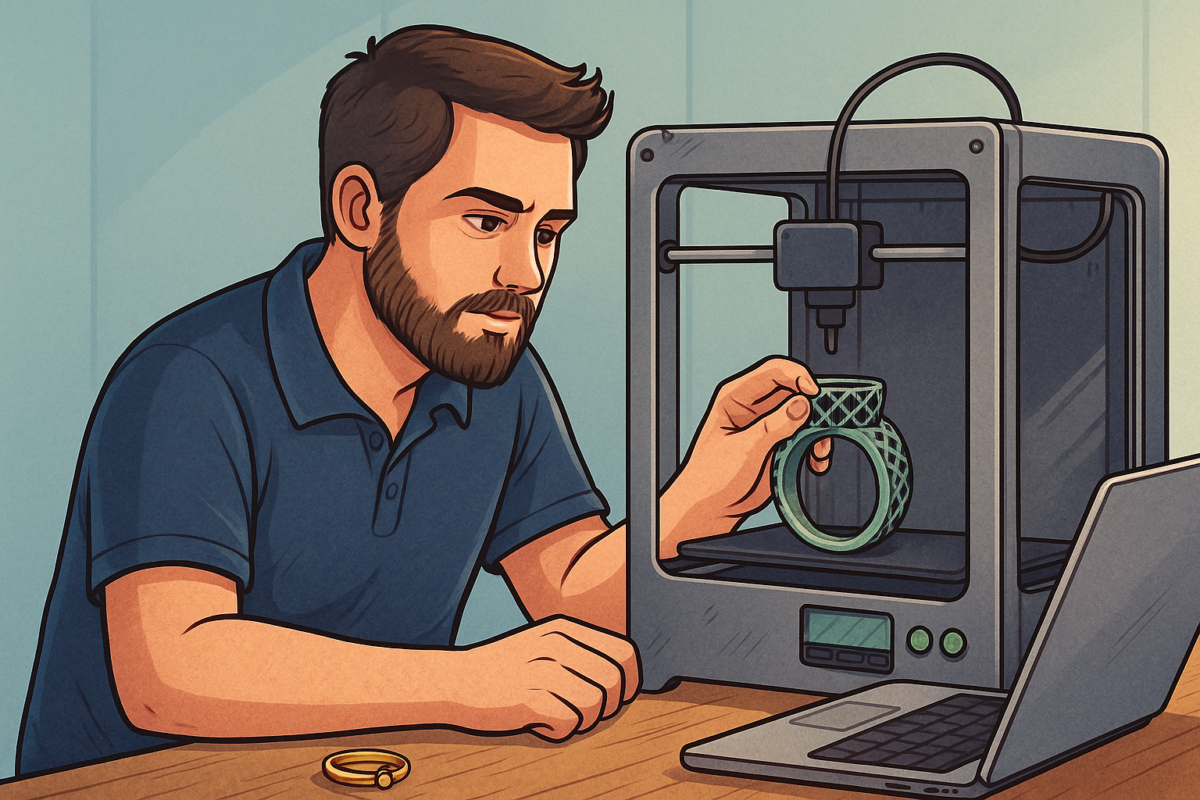Welcome to the Future of Jewelry Making
Imagine creating a piece of jewelry that is entirely unique. A ring with impossible geometry, a pendant that captures a loved one’s fingerprint, or earrings with a design so intricate it defies traditional craftsmanship. This isn’t a fantasy; it’s the everyday reality made possible by 3D printing.
Welcome to the Files Trader blog! If you’re a creative soul, an aspiring entrepreneur, or simply someone fascinated by the blend of technology and art, you’ve come to the right place. Here at Files Trader, we live and breathe 3D jewelry design, providing ready-made 3D files and custom design services to makers just like you.
This guide is your friendly, comprehensive introduction to the world of 3D printed jewelry. We will demystify the technology, walk you through the entire process, and show you how accessible and thrilling it is to turn digital dreams into wearable art. Let’s embark on this exciting journey together!
What Exactly is 3D Printed Jewelry?
At its core, 3D printed jewelry is any piece of wearable art created using a 3D printer. Instead of carving wax by hand or hammering metal into shape, a digital 3D model is sent to a machine that builds the object layer by microscopic layer.
This process unlocks incredible potential:
- Unmatched Complexity: Create designs with latticework, interlocking parts, and hidden details that are nearly impossible to make by hand.
- Total Customization: Easily resize rings, add personalized text, or design a piece from scratch that is one-of-a-kind.
- Speed and Efficiency: Go from a digital idea to a physical model in hours, not weeks.
- Accessibility: You don’t need to be a master jeweler to start creating professional-looking pieces.

Why Choose 3D Printing for Jewelry? The Benefits Are Crystal Clear
Why has this technology taken the jewelry world by storm? The advantages are simply too compelling to ignore.
- Democratization of Design: You are no longer limited by your skill with a file and a saw. 3D modeling software (and ready-made files from stores like ours!) allows anyone with a creative vision to become a designer.
- Perfection and Precision: 3D printers, especially resin printers, can reproduce details finer than a human hair. This means flawless settings for stones, razor-sharp edges, and perfectly smooth curves every single time.
- The Power of Prototyping: Test a design by printing it in cheap plastic or resin before you ever commit to expensive precious metals. This “try before you buy” approach saves massive amounts of money and materials.
- A Gateway to Business: With a 3D printer and a source for great 3D models (like Files Trader), you can start a small business with minimal overhead. Create inventory on demand, fulfill custom orders, and reach a global market online.
Files Trader Insight: Many of our most successful customers started just like you—as beginners with a passion for jewelry. They began by purchasing *ready-made STL and 3DM files* from our store to learn the printing and casting process. Once confident, they moved on to using our custom design services to create their own unique product lines. The journey is entirely within your reach!
The Two Main Paths: Direct Printing vs. Indirect Casting
There are two primary ways to use 3D printing in jewelry making, and understanding this distinction is your first major step.
Path 1: Direct 3D Printing
This is exactly what it sounds like: you print the final piece of jewelry directly in a wearable material.
- Materials: This includes strong, high-detail resins (in various colors and even metallic finishes), nylon, and various plastics.
- Pros: Fast, great for statement pieces and fashion jewelry, allows for complex, multi-color designs.
- Cons: The materials are not precious metals, so the value and feel are different from traditional fine jewelry.
Path 2: 3D Printing for Lost-Wax Casting (The Industry Standard)
This is the most common method for creating fine jewelry in gold, silver, and platinum. Here, the 3D printer is used to create a highly detailed model out of a special casting wax resin.
- You 3D print your design in this wax-like resin.
- This printed model is then attached to a “tree” with other models and placed in a flask.
- A plaster-like material, called investment, is poured around the tree and hardened.
- The flask is placed in a kiln, which burns out the 3D printed “wax” model, leaving a perfect hollow cavity inside the investment.
- Molten metal is poured into this cavity.
- Once the metal cools, the investment is broken away, revealing a metal version of your 3D printed design, ready for finishing and polishing.
- Pros: Creates genuine, high-value metal jewelry; leverages the detail of 3D printing for traditional craftsmanship.
- Cons: Requires more steps and access to casting equipment (which can be outsourced to casting houses).
Your Toolkit: What You Need to Get Started
You don’t need a factory to begin. Here’s a breakdown of the essential tools for a beginner.
1. Hardware: The 3D Printer
For jewelry, SLA/DLP/LCD Resin Printers are the undisputed champions. They offer the high resolution and smooth surface finish necessary for detailed jewelry work.
- What to look for: A high-resolution screen (XY resolution of around 35-50 microns). Popular and affordable beginner models include brands like Anycubic, Elegoo, and Phrozen.
- What you’ll also need: Safety gear (gloves, glasses), isopropyl alcohol for washing, and a UV curing station to harden the prints.
2. Software: The Digital Toolkit
- For Finding Designs: This is where Files Trader shines! As a beginner, you don’t need to learn complex modeling right away. You can browse our extensive library of ready-made 3D jewelry files in STL and 3DM formats, find a design you love, and start printing immediately.
- For Custom Design (The Next Step): When you’re ready to design, software like Rhinoceros 3D (Rhino) with its jewelry-specific plugin, MatrixGold, is the industry standard. This is why we offer many of our designs in the editable .3DM file format—so you can learn and customize.
- For Preparing to Print (Slicer): This software (like Chitubox or Lychee Slicer) takes your 3D model (e.g., an STL file) and “slices” it into layers, generating the instructions for your printer.
3. Materials: Resin
For jewelry, you’ll use a Castable Resin if you plan on doing lost-wax casting, or a Standard/High-Detail Resin if you are directly printing the final piece.
The Beginner’s Workflow: From Digital File to Wearable Piece
Let’s connect the dots and see what the entire process looks like for a beginner using a ready-made file from Files Trader.
- Choose Your Design: Browse the Files Trader store and select a beautiful jewelry piece that catches your eye—let’s say a detailed floral pendant. You download the high-resolution STL file.
- Prepare the File (Slicing): You open the STL file in your slicer software. You orient the model for the best print quality, add supports to hold it in place during printing, and then slice it.
- 3D Printing: You transfer the sliced file to your resin printer, start the print, and wait a few hours. The printer meticulously builds the pendant layer by layer.
- Post-Processing:
- Wash: You carefully remove the print from the printer and wash it in isopropyl alcohol to remove uncured resin.
- Cure: You place the pendant under a UV light to fully harden and strengthen it.
- Finishing (The Magic Touch):
- For Direct Prints: You remove the support structures, sand any rough spots, and perhaps paint or polish the resin to your liking.
- For Casting: You send your cured resin model to a professional casting service (readily found online) who will use the lost-wax process to transform your print into solid silver, gold, or bronze. They will then return the raw metal piece to you for final polishing and assembly.
Common Beginner Questions & Mistakes (And How to Avoid Them!)
- Question: “Do I need to be a tech genius or an artist?”
- Answer: Not at all! Starting with pre-designed files from Files Trader eliminates the need for advanced design skills. The technology is becoming more user-friendly every day.
- Mistake: Skipping safety precautions.
- Solution: Uncured resin is toxic and can cause skin irritation. Always wear nitrile gloves and safety glasses when handling resin and prints.
- Mistake: Expecting a perfect print on the first try.
- Solution: 3D printing has a learning curve. Your first few prints might fail due to incorrect support settings, exposure times, or leveling. This is normal! The online 3D printing community is incredibly helpful for troubleshooting.
- Question: “How can I turn this into a business?”
- Answer: Start by selling your direct-print resin pieces on platforms like Etsy. As you grow, partner with a casting service to offer precious metal versions. Use our custom design services at Files Trader to create a unique brand identity that sets you apart.
Your Next Steps on This Exciting Journey
The world of 3D printed jewelry is vast, creative, and endlessly fascinating. You are standing at the threshold, and the key is to take that first, simple step.
- Educate Yourself: Read blogs (like this one!), watch YouTube tutorials, and join online forums.
- Find Your First Design: You don’t need to build the plane before you take off. The easiest way to get started is to find a design that inspires you.
- Start Small and Experiment. Embrace the learning process.
Files Trader is here to be your guide. We have curated a collection of beginner-friendly jewelry files that are optimized for high-quality printing. By starting with a professionally designed model, you can focus on mastering the printing and post-processing skills without the intimidation of complex design software.
Conclusion: Your Creative Journey Starts Now
3D printed jewelry is more than a hobby or a business; it’s a revolution in how we think about creating and owning adornment. It puts the power of design and manufacturing into your hands, literally.
It bridges the gap between the digital and physical worlds, allowing for a level of personalization and complexity that was once unimaginable. The barriers to entry are lower than ever, and the potential for growth and creativity is limitless.
You have the vision. We have the tools.
Ready to take the plunge? Explore the Files Trader store today to find your first (or next) stunning 3D jewelry project. And when you’re ready to create something that is uniquely yours, our custom design team is here to help you every step of the way. Let’s create something beautiful together.
